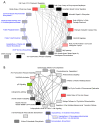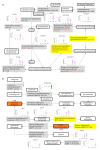Gene Expression over Time during Cell Transformation Due to Non-Genotoxic Carcinogen Treatment of Bhas 42 Cells
- PMID: 35328637
- PMCID: PMC8954493
- DOI: 10.3390/ijms23063216
Gene Expression over Time during Cell Transformation Due to Non-Genotoxic Carcinogen Treatment of Bhas 42 Cells
Abstract
The Bhas 42 cell transformation assay (Bhas 42 CTA) is the first Organization for Economic Cooperation and Development (OECD)-certificated method used as a specific tool for the detection of the cell-transformation potential of tumor-promoting compounds, including non-genotoxic carcinogens (NGTxCs), as separate from genotoxic carcinogens. This assay offers the great advantage of enabling the phenotypic detection of oncotransformation. A key benefit of using the Bhas 42 CTA in the study of the cell-transformation mechanisms of tumor-promoting compounds, including non-genotoxic carcinogens, is that the cell-transformation potential of the chemical can be detected directly without treatment with a tumor-initiating compound since Bhas 42 cell line was established by transfecting the v-Ha-ras gene into a mouse fibroblast cloned cell line. Here, we analyzed the gene expression over time, using DNA microarrays, in Bhas 42 cells treated with the tumor-promoting compound 12-O-tetradecanoylphorbol-13-acetate (TPA), and NGTxC, with a total of three repeat experiments. This is the first paper to report on gene expression over time during the process of cell transformation with only a tumor-promoting compound. Pathways that were activated or inactivated during the process of cell transformation in the Bhas 42 cells treated with TPA were related not only directly to RAS but also to various pathways in the hallmarks of cancer.
Keywords: 12-O-tetradecanoylphorbol-13-acetate; Bhas 42 cells; cell-transformation assay; hallmarks of cancer; non-genotoxic carcinogen; over time; transcriptomics.
Conflict of interest statement
The authors declare no conflict of interest.
Figures










Similar articles
-
Can a 12-gene expression signature predict the cell transforming potential of tumor promoting agents in Bhas 42 cells?Toxicol Lett. 2023 Nov 1;389:11-18. doi: 10.1016/j.toxlet.2023.10.006. Epub 2023 Oct 9. Toxicol Lett. 2023. PMID: 37813191
-
Transformation assay in Bhas 42 cells: a model using initiated cells to study mechanisms of carcinogenesis and predict carcinogenic potential of chemicals.J Environ Sci Health C Environ Carcinog Ecotoxicol Rev. 2015;33(1):1-35. doi: 10.1080/10590501.2014.967058. J Environ Sci Health C Environ Carcinog Ecotoxicol Rev. 2015. PMID: 25803194
-
A Bhas 42 cell transformation assay on 98 chemicals: the characteristics and performance for the prediction of chemical carcinogenicity.Mutat Res. 2010 Sep 30;702(1):100-22. doi: 10.1016/j.mrgentox.2010.07.007. Epub 2010 Jul 23. Mutat Res. 2010. PMID: 20656056
-
In Vitro-In Vivo Carcinogenicity.Adv Biochem Eng Biotechnol. 2017;157:81-96. doi: 10.1007/10_2015_5013. Adv Biochem Eng Biotechnol. 2017. PMID: 27506831 Review.
-
Epigenetic events during the process of cell transformation induced by carcinogens (review).Oncol Rep. 1999 Jul-Aug;6(4):925-32. doi: 10.3892/or.6.4.925. Oncol Rep. 1999. PMID: 10373683 Review.
Cited by
-
A modular strategy for the testing and assessment of non-genotoxic carcinogens.Arch Toxicol. 2024 Aug;98(8):2463-2485. doi: 10.1007/s00204-024-03753-y. Epub 2024 May 29. Arch Toxicol. 2024. PMID: 38811392 Free PMC article.
-
Evaluation of functional candidate biomarkers of non-genotoxic hepatocarcinogenicity in human liver spheroid co-cultures.Arch Toxicol. 2023 Jun;97(6):1739-1751. doi: 10.1007/s00204-023-03486-4. Epub 2023 Mar 20. Arch Toxicol. 2023. PMID: 36941454
-
Addressing Immune Response Dysfunction in an Integrated Approach for Testing and Assessment for Non-Genotoxic Carcinogens in Humans: A Targeted Analysis.Int J Mol Sci. 2025 Jun 30;26(13):6310. doi: 10.3390/ijms26136310. Int J Mol Sci. 2025. PMID: 40650089 Free PMC article. Review.
-
Non-genotoxic carcinogens (TPA and mezerein) activate tumourous transformation through miR let-7-mediated Hmga2 expression in Bhas42 cells.Environ Epigenet. 2025 Mar 3;11(1):dvaf005. doi: 10.1093/eep/dvaf005. eCollection 2025. Environ Epigenet. 2025. PMID: 40182023 Free PMC article.
-
Assessment of the carcinogenic potential of particulate matter generated from 3D printing devices in Balb/c 3T3-1-1 cells.Sci Rep. 2024 Oct 14;14(1):23981. doi: 10.1038/s41598-024-75491-1. Sci Rep. 2024. PMID: 39402095 Free PMC article.
References
-
- Morita T., Hamada S., Masumura K., Wakata A., Maniwa J., Takasawa H., Yasunaga K., Hashizumef T., Honma M. Evaluation of the sensitivity and specificity of in vivo erythrocyte micronucleus and transgenic rodent gene mutation tests to detect rodent carcinogens. Mutat. Res. Genet. Toxicol. Environ. Mutagen. 2016;802:1–29. doi: 10.1016/j.mrgentox.2016.03.008. - DOI - PubMed
-
- Combes R.D. Detection of non-genotoxic carcinogens: Major barriers to replacement of the rodent assays. In: Van Zutphen L.F.M., Balls M., editors. Proceedings of the 2nd World Congress on Alternatives and Animal Use in the Life Sciences; Utrecht, The Netherlands. 20–24 October 1996; Amsterdam, The Netherlands: Elsevier; 1997. pp. 627–634.
-
- Ohmori K., Umeda M., Tanaka N., Takagi T., Yoshimura I., Sasaki K., Asada S., Sakai A., Araki H., Asakura M., et al. An inter-laboratory collaborative study by the Non-Genotoxic Carcinogen Study Group in Japan, on a cell transformation assay for tumour promoters using Bhas 42 cells. Altern. Lab. Anim. 2005;33:619–639. doi: 10.1177/026119290503300616. - DOI - PubMed
MeSH terms
Substances
LinkOut - more resources
Full Text Sources
Research Materials

